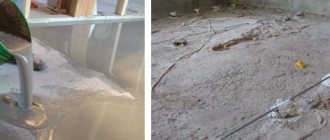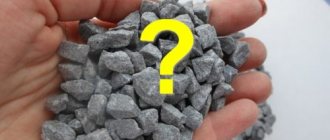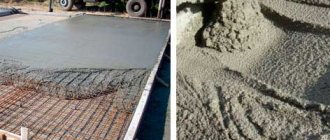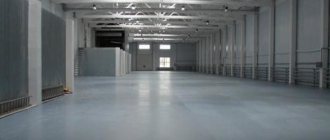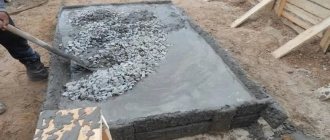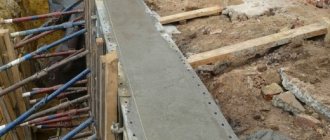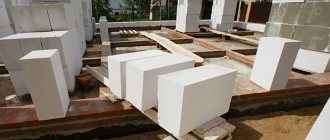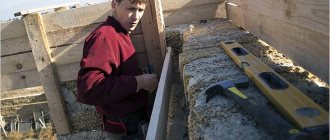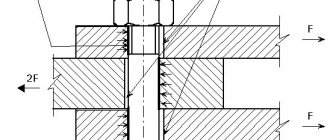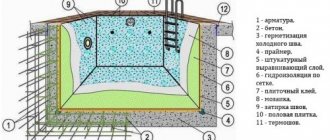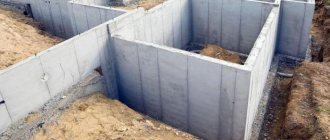The brand determines the quality and characteristics of concrete in terms of strength, resistance to frost and moisture. These qualities determine which brand to choose for construction work. If you make a mistake with the choice, the design will not perform its functions, will serve less than its intended life, or pose a danger to life.
In the article we will look at which brand of concrete is best suited for arranging a foundation, which brand of concrete is poured for floors, and which brand of concrete is suitable for blind areas around the house.
What concrete is best to use for foundation construction?
- What kind of concrete is needed to build a foundation?
- Selecting a grade of concrete Selecting a grade of concrete depending on the weight of the building structure
- Choosing a concrete grade depending on the soil characteristics
To determine which brand of concrete should be used for building a foundation, it is necessary, first of all, to pay attention to the characteristics of the building material.
Which brand of concrete is best for the foundation?
Factors that determine the choice of concrete grade: size, depth, design features of the project.
The bearing capacity of the foundation being created will directly depend on these parameters. Which concrete is better for the foundation?
What kind of concrete is needed to build a foundation?
Calculation of concrete mixture.
The concrete mixture should contain clean sand, and crushed stone or gravel with a fraction of 20-40 mm should be used as a filler. You cannot use limestone or broken brick, as this will greatly reduce the strength of the foundation and the entire building. It is necessary to ensure that no foreign substances get into the composition - clay, gypsum, oils, salts and others. This will significantly reduce the quality of the concrete foundation. The cement must be of exceptionally high quality - grade 500 or 400. The following proportions are most often used to create a concrete mixture: 1 part cement, 4 parts crushed stone and 3 parts sand. Add water to the mixture until a paste-like consistency is obtained. The strength of the foundation being built depends on the density of the concrete mixture. Properly prepared concrete is poured into the formwork and compacted until “cement laitance” appears on the surface.
It is very important to strictly follow the proportions when preparing the concrete mixture. High accuracy is achieved only in factory conditions, in which the required number of components is automatically loaded. The concrete mixture must be free of air bubbles and lumps and have a uniform consistency. If this is not taken into account, then voids, cavities and clots will form in the concrete, which will significantly reduce the strength and quality of the foundation. Plasticizers are introduced into the concrete mixture (when prepared in a factory), which can prolong the hardening period of the mixture in order to avoid the effect of cold joints.
It is very important to know exactly what grade of concrete is needed for the foundation of the house being built.
The amount of concrete that will be needed during construction is indicated in the construction documentation.
Proportions of components for concrete
In recipes, concrete compositions are given by weight or volume. Moreover, cement is always taken as 1, and all other components are taken in relation to it. The proportions for commonly used brands are shown in the table.
Proportions for concrete grades. For foundations, M200, M250, M300 are most often used
As you can see, the same concrete can be obtained using different brands of cement. Fall asleep as you have, only adhering to the recommended mass (or volume) portions. Mostly when pouring foundations, Portland cement M400 and M500 is used. When composing the mixture, remember that if gravel is used instead of crushed stone, 0.05 more water is added.
How to decipher the table instructions? For example, let’s take concrete grade M250, it will be made from Portland cement M400. We will focus on mass. Then select the corresponding line in the third column: 1/2,1/3,9. This means that for one kilogram of M400 cement, we take 2.1 kg of crushed stone and 3.9 kg of sand. The amount of water can be taken from the table below - it is 0.65 kg for crushed stone backfill.
Water-cement ratio for different grades of concrete
If we compose the same concrete based on volume, for example a 10-liter bucket, then we take the proportions from the fourth column: 10/19/34. This means that for 1 bucket of cement, we put 1.9 buckets of sand, 3.4 buckets of crushed stone. The water/cement ratio remains the same: 0.65 buckets.
Sometimes you need to calculate how many components are required for one cube of concrete. These data are shown in the following table.
Proportions of concrete per cubic meter. The mass of the components is indicated in kilograms, parts are given in brackets.
Another table summarizes data on the consumption of M400 and M500 cement per cubic meter of the most popular grades of concrete during foundation construction.
Cement consumption per cubic meter of concrete of different grades
The correct grade of concrete for the foundation is the key to its strength. But high-quality compounds are very expensive. If, according to all the recommendations given, you need to use M300 and higher, it is better to order a foundation calculation that will confirm or refute your assumptions. This service costs about $100-$150, but can save you thousands if you want a lower grade.
Choosing a brand of concrete.
Table of the ratio of class and grade of concrete.
Factors that determine the choice of concrete grade:
- The magnitude of the structural load, which determines the load-bearing capacity of concrete.
- The depth of groundwater, which determines the expected moisture resistance.
- Design features of the project.
When creating a foundation, you can use several types of concrete: from grade M100 (with a strength of 7.5 MPa) to grade M700 (with a strength of 50 MPa). Concrete grades M150 and M100 are used to create strip foundations on slightly heaving soil, with a bearing capacity of no more than 130 kg/m². Such concrete can also be used for pouring shallow and medium-depth foundations for frame and wooden buildings.
Concrete grades M200 and M250 can be used in the construction of foundations with a load-bearing capacity of no more than 262 kg/m². These types of concrete are used when pouring bored piles, slab foundations, buried strip foundations or when creating soles for pillars on heaving soils. The good load-bearing capacity of such grades of concrete allows them to be used in the construction of the foundation for a block or brick low-rise building.
Foundation waterproofing scheme.
Concrete grades M400 and M300 will be a good choice for the construction of buried strips, floating slabs, soles, and bored pile structures. The bearing capacity of such grades of concrete is up to 393 kg/m². These grades are used to create buried foundations for brick multi-storey buildings.
Durable grades of concrete are more expensive than lighter materials. It is necessary to choose the type of mortar very carefully: concrete that is not strong enough will not withstand operational loads, and the use of stronger grades of concrete than necessary will overload the construction estimate.
When choosing concrete, the type of soil and the total weight of the structure are mainly taken into account. The influence of the depth of groundwater passage is offset by the provision of good waterproofing of the foundation. Creating reliable protection of the foundation from groundwater will cost less than using a moisture-resistant solution.
The choice of concrete grade depending on the weight of the building structure.
Reinforced concrete.
In reinforced concrete structures in civil and industrial construction, concrete grades 200 and 250 are most often used.
The load on the foundation is calculated by summing the mass of all elements of the structure. To determine the maximum load, you need to know the density and volume of building materials. The weight of a house can be determined by the average density of 1 m² of ceiling, floor and wall, multiplied by the number of square meters of each structural element of the house. To do this, first of all, determine the quadrature of the walls (by multiplying the height of the facade by the perimeter). After this, the square footage of the floors is determined by multiplying and doubling the length and width of the house facade. Finally, calculate the square footage of the roof by multiplying the length by the width of the slope and increasing the result by the number of roof slopes.
It is necessary to take into account reference data, according to which 1 m² of a brick wall in a house weighs 2070 kg, and 1 m² of a frame structure weighs about 50 kg. In addition to the load from the walls, there is also the load from the weight of the roof, ceiling, and snow load. Thus, concrete grade M400 and grade M500 are suitable for a brick wall, and grade M250 is suitable for a frame wall.
The choice of concrete grade depending on the characteristics of the soil.
Table of density and bearing capacity of various soils.
Depending on the type of soil, the grade of concrete for pouring the foundation is selected based on the level of seasonal soil deformation. This parameter is significantly influenced by the composition of the soil on the site. Sandy-rocky soil can be classified as slightly heaving soil. To pour the foundation in such an area, you can choose concrete grade M200.
This variety is not recommended for use on clay and loam. If the soil is very susceptible to heaving, grade M300 and grade M400 are more suitable for filling. In addition, the bearing capacity of the soil should be taken into account in the calculations. This indicator affects both the base area and the type of concrete mixture.
How to improve the performance of concrete?
Application of superplasticizers.
The use of superplasticizers increases the strength and protective qualities of concrete.
Whatever concrete you choose, there is an opportunity to improve its performance: moisture resistance and heat resistance. To reduce the cost of building a foundation, it is especially important to change the moisture resistance of the foundation. This can be done by introducing a hydrophobic layer into the structure of the base. The waterproofing layer is placed under the sole, securing a moisture-resistant film to the bottom of the pit (before pouring the base). After pouring, it is necessary to insulate the vertical walls of the foundation and cover the grillage with roofing material.
Another option to improve the moisture resistance of the base is to add a sulfate-resistant element to the concrete. Thanks to it, you can avoid the rather complicated procedure of creating waterproofing. A foundation built from such concrete can withstand the negative effects of groundwater for a long time.
The introduction of special additives into the solution makes it possible to shorten the construction period and reduce the labor intensity of the work.
Brand of concrete for the foundation of a private house. What grade of concrete is needed for the foundation.
Concrete is a modern building material that rivals natural stone in strength. Its high performance properties have made it popular in all types of construction work, including foundation construction. While lightweight structures can use columnar foundations, capital structures require a high-quality strip or pile foundation, the characteristics of which directly depend on the choice of concrete grade, skillful mixing and carefully selected composition.
What kind of concrete is best to pour the foundation.
Features of houses built from monolithic reinforced concrete
Reinforced concrete is a cheap, durable, and warm material (however, it is “warm” not in the literal sense of the word, but in the operational sense).
Monolithic concrete, like brick, is more of a heat insulator, since it accumulates the heat generated inside the house, but does not release it to the street, like foam or aerated concrete, but returns it back to the premises if they begin to cool down.
The fact is that the concrete wall warms up only about halfway; the heat does not reach the outer part of the wall. If you plaster a concrete wall from the outside, it will not freeze, and not a drop of heat will escape from it to the street.
Composition of the mixture.
There are two main components in a concrete mixture:
- Fractional filler (sand, crushed stone or gravel) is a “power” element that absorbs all loads. Volume fraction in the composition – up to 80%.
- A binder resulting from the contact of a cement mixture and water. Volume fraction in the composition – up to 30%.
The ratio of the listed substances in the concrete mixture can be different, depending on the brand of cement, the moisture content of the filler, and the presence of additives. The foundation is the load-bearing part of the building, therefore, to ensure resistance to design loads, it is necessary to correctly select the composition of the concrete mixture. Concrete works well in compression, which allows the foundation to successfully withstand the pressure of the ground structure. The reinforcement cage used in the foundation also provides strength in the transverse direction during soil movements.
The choice of concrete for the foundation depends on the design of the building being constructed. There are different requirements for the foundation, which leads to the use in practice of a wide range of concrete grades.
To answer the question of which brand of concrete is suitable for the foundation of a private house, let’s consider the main types.
Concrete grade M150.
In terms of its characteristics, this brand of concrete is not much different from M100. The main application is preparatory construction work. Only the lightest strip foundations of one-story light houses made of wood or hollow blocks, garages and sheds can be poured from M150 concrete. This brand of concrete for the foundation of a private house is permissible only if the rocky soil will act as a reliable foundation. The foundation cannot be deepened due to the danger of groundwater; otherwise, the use of waterproofing (liquid rubber) is mandatory.
Features of houses built from aerated concrete
Another popular material, aerated concrete, behaves no better than foam concrete in winter, and in difficult climates it behaves much worse. The fact is that instead of closed cells, like foam concrete, its mass is penetrated by open pores, into which moisture penetrates easily and quickly. If aerated concrete gets wet, it will never dry, it will be damaged.
Therefore, aerated concrete walls need to be very strongly protected from moisture, which, of course, costs the builder a pretty penny.
Alas, this material cannot be completely protected from moisture, because waterproofing does not last forever, it also deteriorates very quickly. Thus, literally in a few years, even a well-built aerated concrete house will become damp and begin to collapse. And this is not fiction, but reality - there are many examples that houses built from aerated blocks very quickly fell into disrepair.
Concrete grade M200.
This concrete is already stronger and is often used in the construction of low-rise (up to two floors in height) buildings and structures with wooden or metal floors. Concrete grade M200 can be used to manufacture reinforced concrete products, for example, piles or floor slabs. The main area of application in residential construction is pouring foundations for frame-panel houses. Only sandy soil is allowed, and groundwater should not rise to the freezing point, and their seasonal fluctuations should be taken into account.
Which concrete is better for the foundation?
Application of the main grades of concrete by strength
- M-100
is used for carrying out preparatory procedures before pouring monolithic foundation strips and slabs. This concrete is laid in a thin layer on a sand bed. After this, reinforcement for the future structure is installed. - M-150
is used when performing preparatory operations before pouring the foundation. It is also used for screeding and pouring floors, building foundations for small structures, and concreting paths. - M-200
is used for pouring paths, for blind areas, foundations, concrete floor screed in residential premises and for garage floors. - M-250 and M-300
are used to create a monolithic foundation, fences, stairs, supports, floor slabs with a small or medium load, respectively, and concrete blind areas. - M-350
is used for the manufacture of a variety of critical structures, for example, monolithic foundations, floor slabs, crossbars, columns, swimming pool bowls, and so on. - M-400
is used in the construction of bridges, cash storage facilities, hydraulic facilities and structures with special requirements. - M-450, M-500, M-550
are used for the same purposes as M-400, as well as in the construction of subways, dams and dams. - M-600
is used in the construction of facilities that are resistant to aggressive environmental factors and have maximum strength. Such objects include reinforced concrete bridge structures, reinforced concrete structures for special purposes, and hydraulic engineering facilities.
Concrete grades M250 and M300.
Cement content is average. M250 grade of concrete is used for the foundation of a house (for pouring) up to three floors. Grade M300 is a more durable concrete; it is used in the foundations of cottages with a height of up to five floors. According to building codes, concrete grade M300 is allowed to be used for the manufacture of monolithic floors. Finds application when filling swimming pools. Concrete of these grades can be used when constructing a foundation on sandy soils, as well as on gravel or crushed stone soils with a relatively high groundwater level.
M400
This building material is much stronger than those described above. This brand of concrete is ideal for strip foundations. It is used in the construction of high-rise buildings.
Such concrete is produced from cement and specially selected fillers. It is also used for the construction of one-story houses. If you use M400 concrete in the construction of high-rise buildings, then their number of storeys should not exceed 20.
Concrete grade M350.
One of the most popular brands of concrete in construction. Significantly superior to M300 not only in strength, but also in frost resistance. It has a long declared service life.
Suitable for the construction of multi-storey buildings, used in the construction of consoles, ceilings and other critical structures. When constructing a foundation, concrete grade M350 can be used for a one-story brick residential building. Suitable for difficult clay soils and places where the groundwater level is high. Loams and clay soils are the most common. When clay freezes, it increases in volume, which can lead to deformation of the foundation if the grade of concrete is incorrectly selected.
Useful tips and tricks
The same grade of concrete can be produced in several ways. An obligatory component is cement, so you can experiment with its types, maintaining the desired proportion, and vice versa. According to the rules, it is believed that the grade of cement should be one and a half to two times higher than the grade of the corresponding concrete. For example, if you mix the solution yourself, then to get M200 concrete, take cement grade M300, no lower. This must be done if you intend to strictly observe the established proportions of the components. If you want to use cheaper cement, simply increase its percentage in the total volume. Accordingly, you can take less of the more expensive cement.
To save money wisely, you can do without waterproofing the foundation. In this case, you can add the appropriate components to the solution or buy hydraulic concrete instead of commercial concrete. Then there will be no need for additional strong waterproofing of the foundation.
Professionals recommend that to create the strongest foundation, it is better to choose concrete grades on granite crushed stone. This is the most durable and durable material.
What grade of concrete is needed for the foundation?
Concrete of a lower grade is cheaper, but when building the foundation it is better to provide some margin of safety, especially for those cases when it is planned to make the basement residential. What grade of concrete is needed for the foundation? Concrete grades M350, M400 have a higher density, and therefore moisture will penetrate through it less easily, and the base will be drier. Sometimes, when building irresponsible structures on poor soil, it makes sense to consider what is more profitable: using a higher grade of concrete or using cheaper concrete, but treating the foundation with waterproofing to protect it from groundwater.
The easiest way to determine what brand of concrete is needed for the foundation of a house, and which brand to choose, is to pre-order design and estimate documentation to the designer. It defines suitable grades of concrete for each type of work, including foundations, and additional properties that the solution must satisfy, such as:
Which concrete is better for a monolithic foundation?
- density,
- waterproof (protection from groundwater),
- frost resistance (the higher, the more suitable for harsh climates),
- fluidity,
- fire resistance.
However, the brand of concrete for the foundation of a private house can be selected independently. To do this, it is necessary to take into account the following features of the structure being built:
- weight of the structure, number of storeys, presence or absence of a basement,
- geological survey of the site: the type of soil and the depth of groundwater are determined,
- type of foundation: strip, pile or any other.
Each of the factors listed above influences what kind of concrete is needed for the foundation, the choice of concrete grade taking into account its special characteristics, etc.
A concrete monolithic foundation is subject to multidirectional forces along its entire perimeter. The foundation should be deepened into the ground so that it is below the freezing level. Specific freezing depths vary widely, depending on soil and climatic conditions. In general, for middle latitudes the freezing level is 0.9-1.5 m. It is recommended to choose the laying depth with some margin. Reliance on a soil base that is not subject to freezing saves the strip foundation from frost heaving deformations.
What concrete is best to use for the foundation.
For a strip foundation, lower grades of concrete are suitable, but a pile foundation, on the contrary, requires higher and stronger grades. Pile foundations are used in the construction of permanent multi-storey buildings. Strip foundations are equipped for low-rise construction.
How to choose a brand, what to look for
The relatively low price of samples with low grade strength is, of course, more attractive due to the overall estimate for the construction of a particular building. However, an omission, even a small one, in the load-bearing capacity of the cast foundation can lead to the destruction of the foundation and the structure as a whole.
Before the final decision on purchasing a mortar mixture with delivery or materials for its preparation on site with your own hands, you need to perform a number of calculations:
- mechanical load from the ground, the house along with furniture, household appliances and people;
- safety margin for errors and unforeseen circumstances;
- depth and height of the basement part of the foundation structure.
It is easier to approach the search for alternative options with the help of specialists from the design organization. Here, based on the developed project and geodetic/geological research, scientific and technical calculations with a list of acceptable solutions will be proposed. Each criterion for selecting materials is also described. These are water absorption, density, load-bearing capacity, compressive and tensile strength, resistance to frost, heaving of the earth, fire and the issue of fluidity of the working mass with the shrinkage phenomenon.
Strength class
Table 1. Strength classes of concrete
Along with the grade of concrete, the manufacturer indicates the strength class of the mortar for compression and axial tension. The criterion is designated by the letter “B” or “Bt”, respectively, by digital indication. The latter can range from 3.5 to 80 units. As a rule, for the construction of foundation structures, indicators from B7.5 to B40 are considered.
If the brand indicates average values for resistance to mechanical load, then the class implies warranty indicators. The latter are controlled by the current state standard of 1991 with the number 26633.
Selection criteria for the tape variety
The criteria mean the essential characteristics of the concrete solution that are acceptable for constructing a foundation under certain conditions. These include the composition and depth of soil freezing, the level of groundwater flow. By and large, all questions come down to general ones:
- density;
- strength;
- load bearing capacity.
Upon closer examination, the criteria for choosing a concrete solution will look like this:
- the total mass of the building, number of floors and the nature of the underground space;
- the nature and behavior of the soil layers involved in construction;
- type of foundation being built (solid/slab, local/strip, point/pile and other options for monolithic structures).
The load on the tape for calculations is taken into account not only from the side of the planned structure. The impact is also caused by soil and ground flows.
If a small house is being built according to the project, then a margin is added to the results regarding the structures. For large cottages and high-rise buildings, this approach is excluded, since the results must be as accurate as possible.
Selection of concrete mortar composition and mixing.
Despite the similar designations, the grade of concrete and the grade of cement are completely different concepts. The number in the cement grade indicates the strength of the cement mortar.
Since the design of the foundation involves its reinforcement in order to ensure lateral strength, it is optimal to choose crushed stone or gravel of the middle fraction. Crushed granite gravel provides the best traction.
As for sand, in theory it is recommended to use sea sand, but regular sand from a sand quarry will do. It is important to note that the sand should be pre-strained to remove clay and other unwanted inclusions.
What concrete is best to use for a strip foundation?
There are no special requirements for water; ordinary tap water will do. The cement-water ratio is 2:1.
The preferred method is to use a concrete mixer, but manual mechanical mixing of the solution is also possible. To do this, you will need a volumetric container into which sand, gravel or crushed stone and cement are added in a certain ratio. After mixing the dry ingredients well, you can gradually add water, stirring constantly until a homogeneous mass is formed. It is important not to overdo it with the amount of water.
Required Tools
To prepare a concrete solution, the following tools may be required:
- Concrete mixer. An electric one is best, but if you don’t have one, you can use a regular manual one.
- Container for mixing the solution. A regular trough will do. If a concrete mixer is used, the solution is mixed in it.
- Buckets. They will be needed to deliver water and any other components.
- Shovel It is needed to mix the solution.
- Large sieve. It is necessary in order to filter out any clogs or debris caught in the sand.
Very often people ask how much concrete is required for a foundation. What are the standard proportions of its composition? The answer to the first question depends on the base area of the object being built. On average, about 330 kg of cement is used per 1 m3 of solution. To prepare high-quality concrete, crushed stone, sand and cement are required in a ratio of 5:3:1.
Calculation of the required amount of concrete.
Incorrect calculation threatens a shortage of material or the formation of surplus, which is also undesirable.
Which concrete is better for the foundation of a house?
The volumes of the slab, strip foundation strips, and pillars are calculated separately, which are then summed up. The calculated value is multiplied by the concrete shrinkage coefficient, the value of which is taken from the passport. Since the reinforcement also takes up some volume in the formwork, to take this into account, the volume of concrete should be divided by a factor of 1.05. The resulting value is rounded up.
